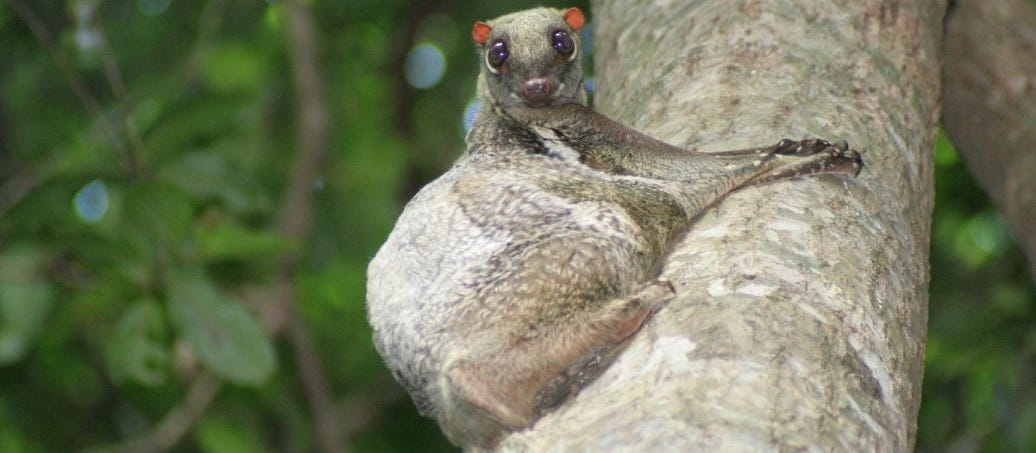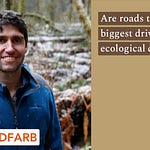Re-posted from here to match the podcast layout.

Parlement of Foules is perhaps the first Valentine’s Day poem ever written and the earliest record of squirrels in the English language.
Squyrelis & bestes smale of gentil kynde
Chaucer, c1381, gently omitting their habit of infanticide.12
The word traces back to Ancient Greek for “shadow-tailed”.
Rodents are worth studying for their own sake says Ornella Bertrand. We've used them in studies for making human lives better and more comfortable, but we don’t often pay attention to them for their own sake.
Ornella studies the natural history of rodents, early mammals, and their brains at the Catalan Institute for Paleontology in Barcelona.3
She creates virtual endocasts, the void of a skull, which can be printed and shared as 3D models.
She is currently investigating evolutionary changes in the brain and inner ear of arboreal and gliding mammals, like flying squirrels and marsupials.
We spoke in February 2024.
Ryan: When you look at burrowing and arboreal rodents, do you see differences in sociality?
Ornella: Sociality is fascinating, but it's difficult to estimate in the fossil record. You might find a bunch of fossils that died together.
Naked mole rats are extremely social, have a queen, and very interesting social behavior.
But other fossorial (burrowing) rodents like the mountain beaver that lives in the Pacific Northwest of America, it's solitary. It's a weird little guy, with long nails, and not super social. They meet for mating.
Marmots and prairie dogs are members of the squirrel family, who are very social and live together. Marmots live in the mountains around rock piles, and prairie dogs in the prairie.
One thing I was trying to figure out in my paper was changes in the neocortex. It is one of the major parts of the brain that changed in squirrels. It has to do with the integration of senses, auditory, vision, and memorization. I wanted to see if they were bigger in animals that were social or arboreal, and tease those variables apart.
I could see there was a trend that all ancestor squirrels had a relatively big neocortex. From a paleontological perspective, I can't tell you which part of the neocortex is bigger. My hypothesis has been you may acquire a larger neocortex for one reason. And for early squirrels, I think it was becoming arboreal and going into trees. And that ended up being part of the neocortex related to vision. It became bigger because in trees, you need good vision to be able to jump from one branch to another.
In marmots and prairie dogs, you also have a big neocortex. I thought that maybe the big neocortex that the ancestor used to become arboreal might have been repurposed for sociality.
Studies on modern rodents show that some actually have a bigger prefrontal cortex, which is the area that helps with communication and interaction with others.
I’ve been mixing what has been done on modern rodents based on actual brains, and what I can hypothesize based on fossils.
Ryan: Mice and rats were studied in labs for a long time before anybody noticed they were communicating with ultrasonic and ground vibrations. How do you think about their language capacity?
Ornella: We think that gliders might do echo-location, but you have to record a lot of time to catch this kind of sound.4
All placental mammals have the same structures of the brain, like exactly the same. Some are less developed than others, but we all have a common ancestor, and the ancestor has the same parts of the brain.
Have you seen those videos of dogs with buttons that they press and the button says a word? I love this. We are part of the animal kingdom. If we ask the right question, they're going to answer us.
If I put you in the skin of a squirrel in the trees today, I make you a squirrel with a human mind, you’re probably the worst squirrel ever. You'd probably die quickly because you're not adapted to their world. You’d be the worst one.
All the others would look at you like what the hell are you doing? You would look dumb and not understand how other squirrels are communicating with you.
I would like to see more of this thing like the talking buttons to communicate with animals, because I feel like they are so smart in ways we don't know. I'm really eager to see that.
Ryan: You wrote about how sometimes evolution rewinds brain structures when they become less useful. How common is that reversal of brain capacity? Is it sort of the rule that things tend to get smarter except in rare cases, or is it possibly more common that brain size gets reduced?
Ornella: I think the more we study it, it's going to be clear it is more common. That is something I'm really interested in. I'm glad you asked me that.
Normally we think things become smarter and smarter, but actually you need a specific environment in which you need to adapt. Depending on the environment, it might not be the solution to have the biggest brain. Having a very big brain is extremely metabolically expensive.
Humans eat so many times per day, we sleep so much, we need to take care of our big brains. It has an advantage and we found a way to adapt to our own environment.
The mountain beaver is a good example from my papers. This animal lives underground. It doesn't really need much vision. Why would you have a part of your brain that's costing so much energy if you're not using it?
The mountain beaver shows a reduction of the neocortex compared to its arboreal ancestors.
It might start with selection that reduces the size of the optic nerve and reduces the size of the eyes. This part of the brain reduces.
It seems normal for another part of the body to change, but for the brain, we always say no, it's different, but it's the same. It's an organ like the rest of your body, so you will adapt to the environment.
Ryan: How is 3D modeling and printing changing your field of study?
Ornella: When I get to print them, which isn’t often, I want to show the public. It can be amazing.
This changed our field so much. I was able to test hypothesis that were done in the 70s using water displacement techniques we wouldn't use today because we can actually get virtual endocasts.
I had a professor who told me, “Oh my God I can't believe you got a virtual endocast of this fossil!”. It was a fossil that was described for the first time in 1910. It was one of the oldest known rodents. It was a very genuine email from this older professor, and it made me feel very good.
When you have a unique fossil you don't want to touch it.
Sometimes when they had a lot of specimens, they would take the fossil and actually break it to look at what the endocasts look like. That was the first step of paleo-neurobiology. I'm so glad we don't have to do this anymore.
I never know what it's going to look like [the endocast]. It's like a new fossil on its own. It's a very interesting development of biology to have access to that.
When you have the 3D models in your hand you can touch the surface, and sometimes you can feel a formation that you might not be able to grasp on the screen.
Ryan: For gliding mammals, is there an area of the brain that if it was damaged, you think it would make them worse at gliding and landing?
Ornella: To study brain function, in the past they would cut part of the brain and see how the animal would do. They did this to the petrosal lobules in macaques. What happens if you cut them is the eye doesn't focus anymore.
It's pretty horrible and it's not something I would want to work on. They have a very big role in maintaining eye position. When you’re an arboreal squirrel (not a glider), when you jump it seems the petrosal lobules might be super important, especially if you go to a branch that's very thin. You want to have good control of your movement so you can really quickly adjust to get that branch.
Gliding squirrels are really interesting and they make my life complicated. That's my project here, to expand to gliding mammals beyond gliding squirrels, and see if there's similarities between the brains of gliding marsupials and other gliding rodents.
Gliding squirrels have smaller petrosal lobules, part of the cerebellum. One of the reasons that could happen is because when animals are gliding they need to be more aerodynamic. They aren’t jumping onto a thin branch, they're jumping onto a trunk. Speed is important because they're not really flying, they're trying to not fall.
This change in locomotion from arboreal to glider, for me, changes things in the brain. Maybe vision is not as important as it is in an arboreal squirrel.
Most gliders are nocturnal. When you’re nocturnal you don't need that much vision actually. Hearing is probably more important.
That's one thing I want to look at, do gliders have better audition. Looking at the cochlea, the inner ear, to see if there is an opposite trend of less vision, more audition compared to their closest relatives. I think that could be linked.
The flocculus and petrosal lobules are features under the cerebellum.5
The heaviest glider, at 1-2 kg, is the Sunda colugo or Sunda flying lemur, Galeopterus.

An exceptionally well-preserved skull found in South America, dated 2-4 million years ago, puts the size of the largest known fossil rodent at 1000 kg, Josephoartigasia monesi.6 This would have been contemporary with our ancestor Australopithecus and terror birds.
Ryan: I have a recurring dream where I'm being chased by a velociraptor that can jump and glide 100 feet. Do you think that's a genetic memory or just my imagination?
Ornella: I did a presentation when I was an undergrad about dreams because I was really interested in this. I was really into lucid dreams in which you control what you're doing to a certain extent.
I don't know, but it's very interesting to think our dreams could be remnants of deep ancestor mammalians.
They were doing crazy stuff in the trees and dealing with things like dinosaurs. I don't know, why not? It's hard to tell you no it's not possible because who knows?
Ryan: How have predators of rodents adapted their locomotion to be effective hunters? Are they more or less doing the same things they were doing 10 million years ago?
Ornella: Recently I saw a video that was pretty cool of this arctic fox. Apparently, it used the magnetic field to catch rodents under the snow. They were successful 75% of the time when they jumped north.7
Of course, you need complete silence.
Did those behaviors exist 30-40 million years ago? We look at bones. If they are morphologically similar to arctic foxes, maybe they would.
Sometimes you have a morphology, and they might not use it the same way. Have you heard of goats that climb trees? At first you're like wait a second, goats are not supposed to go in trees, but they're able to do it.

The best thing you can do is look at what modern mammals are doing. I look at videos because it helps me imagine what they would be able to do in the past.
Early carnivores, primates, and whales are the three groups that increased their brain size really fast.
Herbivores like horses and cows also had an increase in brain size through time.
It’s difficult to know how behaviors and hunting strategies changed. But there’s a hypothesis of an arms race. Carnivores get smarter to get prey, and the herbivores get smarter too, at least a little bit to escape the predator.
Ryan: How have Ice Ages in the last 3 million years played into that?
Ornella: The Ice Ages are a very cool question. There was a paper a couple of years ago on relative brain size.8
What they found was when the megafauna disappeared you had a relatively smaller brain. And mammals that survived like modern wolves, rhinos, and elephants, had a bigger relative brain size (encephalization). But they say it was already starting before the extinction.
They need more data to see exactly which parts of the brain are changing. But the ice ages definitely had a huge effect on population extinctions and new populations taking over.
The skulls are usually really big. Big CT scanners cost more money, and sometimes it's difficult to move big specimens. You have to ask the museum, “hey can I borrow your giant rhino?”, and they're like “how are you gonna carry it?”.
But with rodents, I can put it in my pocket and use the micro CT scanner. It's easy.
For the Ice Ages there's a huge amount of open field.
Ryan: If humans disappeared, how would you rate the odds of rodents rising to build a planetary civilization? Could they become predators? Could they become bipedal?
Ornella: First of all, anything as possible. In the light of evolution it really depends what's around you.
Humans became what they are because of other species around them. The climate was very specific.
What humans did is what humans did. If another species was to rise, I don't know if they would become like humans.
I don't know if there would be another civilization.
We have such a huge brain compared to even the other primates. It's an anomaly.
It's very weird the way we came to have such big brains, because it's so expensive to maintain. All our body is modified to accommodate the brain. The fact that we're bipedal.
To be fair whales and carnivores also have relatively large brains. And they find ways to communicate.
The first hominids, like Australopithecus, were living like other species. Then from agriculture to the modern lifestyle there have been billions of people. This huge quantity of humans got us to this point.
I always think of humans being weird.
For more of the interview, check out the audio.
Ornella Bertrand’s latest publication is How Smart was T. rex?, and previously, Brain Evolution in Fossil Rodents. Her virtual endocasts are posted on Morphosource.
Origin of the word squirrel https://www.merriam-webster.com/wordplay/the-history-of-squirrel
Flying squirrel infanticide http://dx.doi.org/10.3106/ms2020-0098
Ornella’s website https://ornellabertrand.wordpress.com/
Echo-location in flying lemurs https://doi.org/10.1080/09524622.2018.1463294
Guy in a lab coat explains the function of the flocculus in more detail than you asked for.
Largest rodent https://www.ncbi.nlm.nih.gov/pmc/articles/PMC2599941/
Foxes use of magnetic fields https://royalsocietypublishing.org/doi/10.1098/rsbl.2010.1145
Ice Age brain size and extinction https://www.nature.com/articles/s41598-022-07327-9







